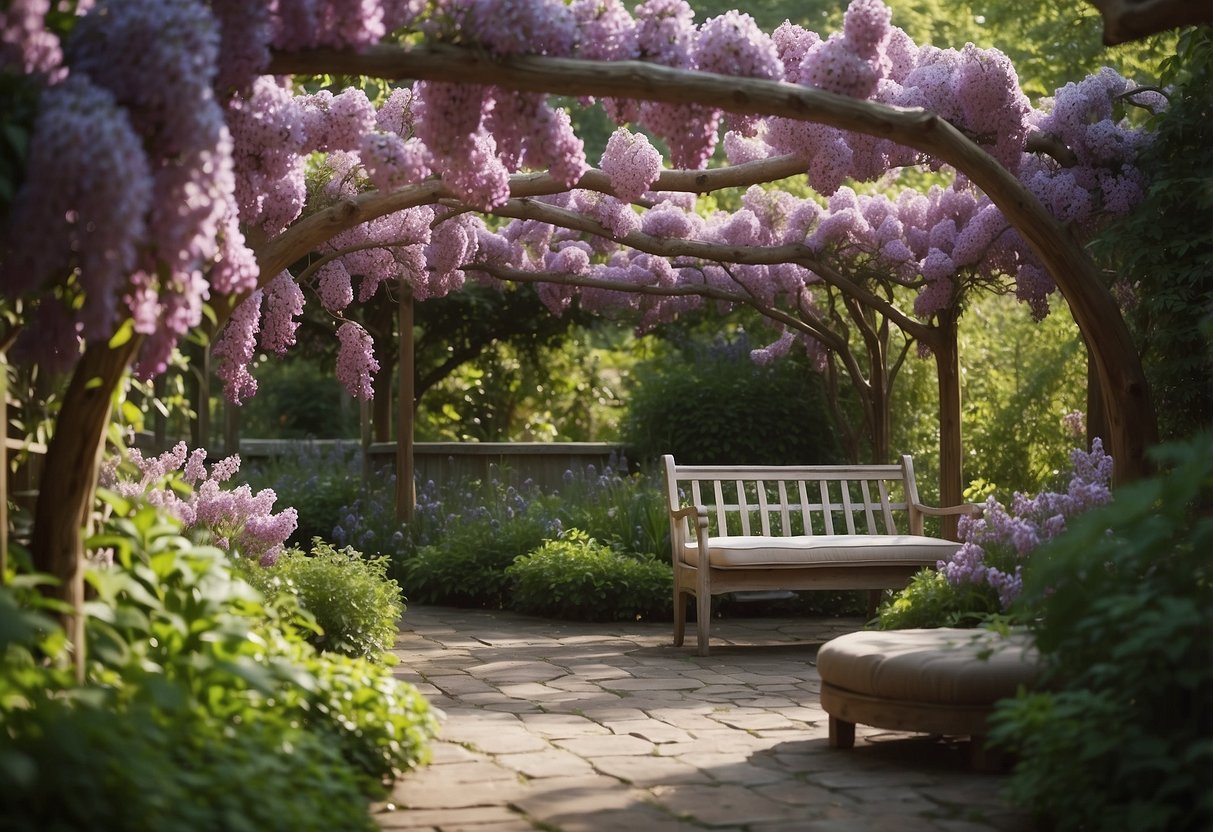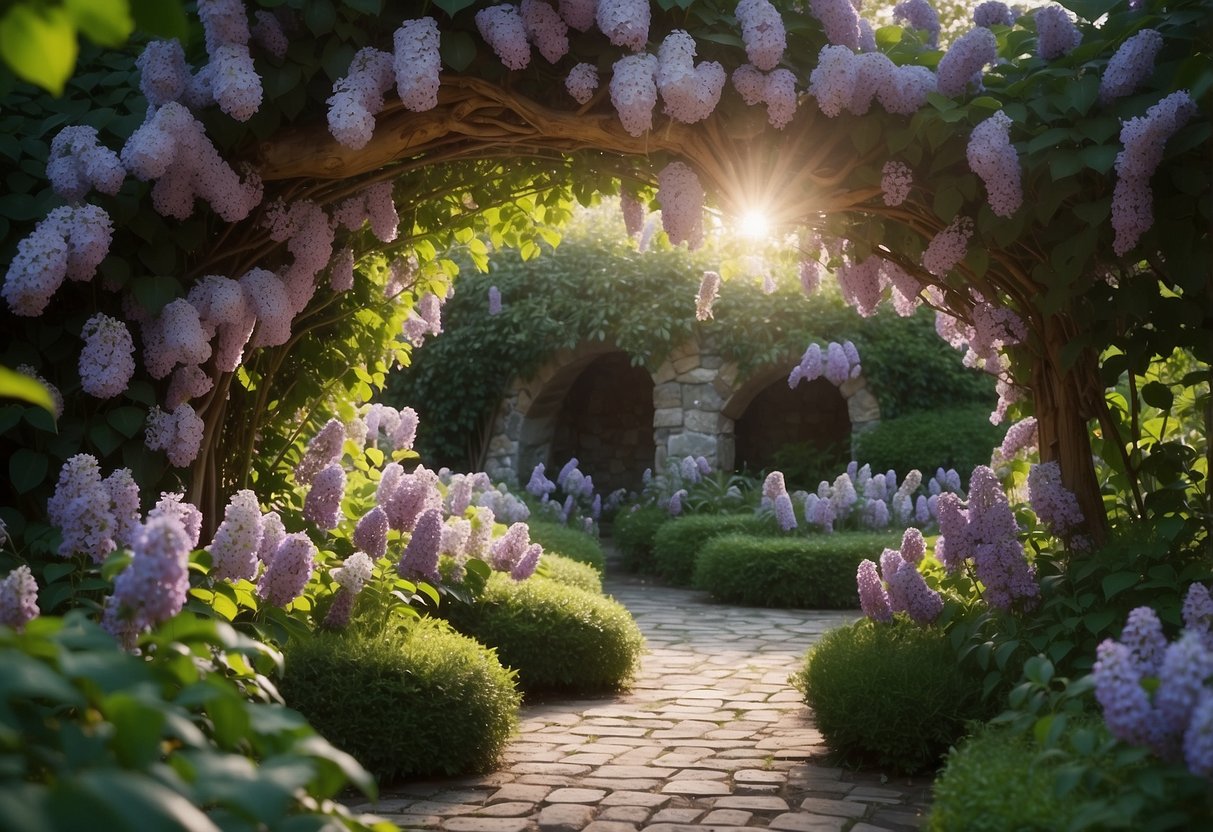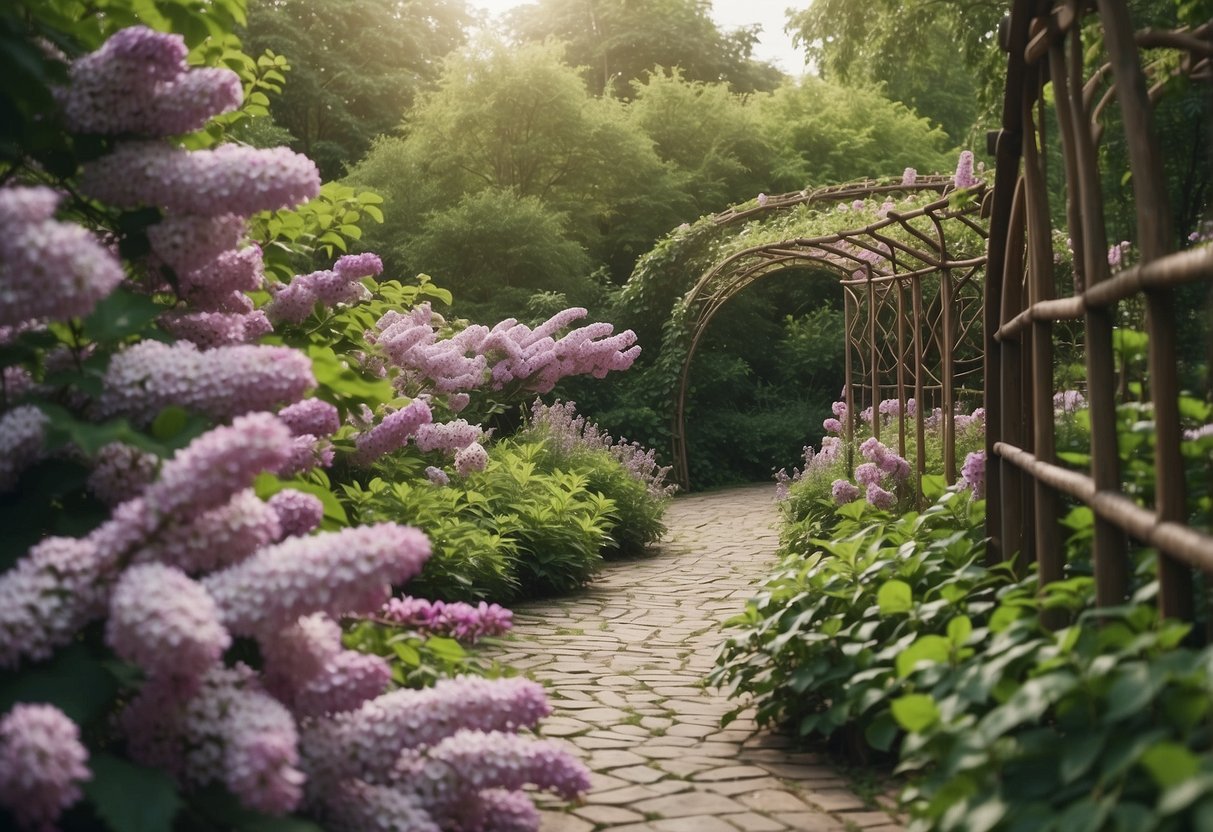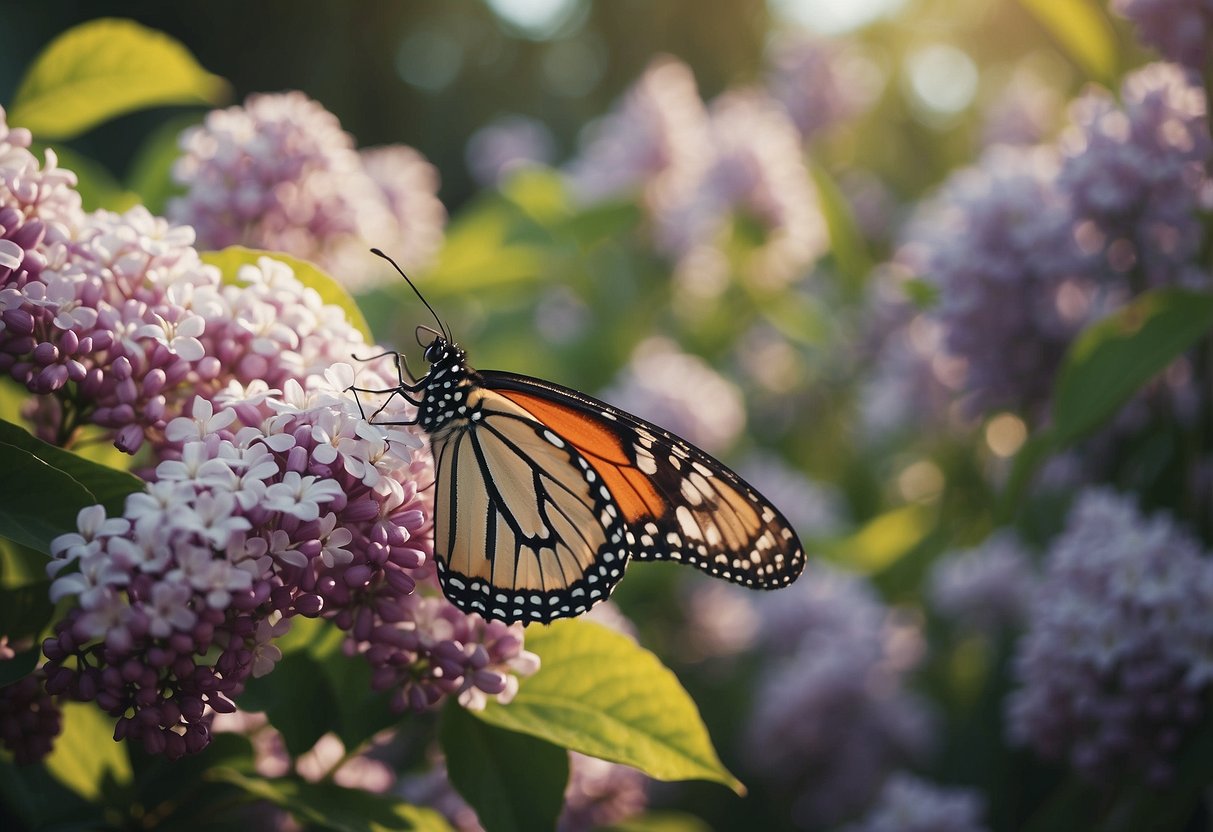Lilac Garden Ideas: Beautiful Designs for Your Backyard
Lilacs are a beautiful addition to any garden, offering both vibrant colors and a delightful fragrance. These plants can transform your outdoor space into a serene and picturesque spot. With their range of varieties, you can find the perfect fit for any garden size or style.

What are some creative ideas for incorporating lilacs into your garden to maximize their visual impact? Whether you’re looking to create a cozy corner or a sweeping floral display, there are endless possibilities for using lilacs to enhance your garden’s beauty. Stay tuned to explore various ways to design and cultivate a stunning lilac-filled garden.
1) Lilac and White Garden Pathway

A lilac and white garden pathway can transform your yard into a serene retreat. Plant lilac bushes on both sides of the path for a fragrant and colorful border.
Consider adding white flowers like daisies or tulips to complement the lilacs. This combination will create a beautiful contrast and make your pathway stand out.
Try using white gravel or stepping stones to complete the look. This will enhance the visual appeal and provide a charming walkway through your garden.
2) Lilac Arch Entrance

Creating a lilac arch entrance adds charm to your garden.
Lilacs bloom beautifully in spring, offering sweet fragrances and vibrant colors.
You can train lilac vines to grow over a sturdy arch, creating a magical entryway.
For best results, ensure your lilac arch gets plenty of sunlight and well-drained soil.
Prune regularly to maintain shape and encourage new growth. This will keep your lilac arch looking fresh and inviting year after year.
3) Fairy Tale Lilac Alcove

Create a cozy nook in your garden with Fairy Tale Lilacs, which are compact and fragrant bushes. Arrange them in a circular pattern to form a secluded space.
Add a small bench or chair for a peaceful seating area. These lilacs grow 5 to 6 feet tall, ideal for providing privacy.
Incorporate fairy garden accessories like tiny doors or fairy figurines to enhance the magical feel. This will make your alcove enchanting and inviting.
4) Victorian Lilac Gazebo

Imagine stepping into your garden and seeing a beautiful Victorian lilac gazebo. These gazebos are perfect for creating a charming retreat in your backyard.
With intricate detailing and classic designs, a Victorian gazebo blends well with lilac bushes, enhancing the overall elegance of your garden.
You can add comfortable seating and soft lighting to create a cozy space. Enjoy your mornings or evenings in this serene spot surrounded by the lovely scent of lilacs.
5) Lilac Rock Garden

A lilac rock garden combines beautiful lilac blossoms with the natural texture of rocks. Start by selecting a sunny spot in your yard since lilacs need at least six hours of sunlight daily.
When planting, make sure your lilacs have good drainage. Place rocks around them to help with drainage and give an artistic touch. The rocks also prevent soil erosion and keep the plants’ roots cool.
Choose different types of rocks and arrange them in interesting patterns. You might mix larger boulders with smaller pebbles to create a pleasing visual contrast. Planting lilacs of various colors adds more charm to your garden.
6) Lilac and Rose Companion Planting

Pairing lilacs and roses can create a stunning garden. Both plants thrive in full sun and well-drained soil. This makes them perfect companions.
Roses add vibrant colors and a variety of shapes to your garden. Their blooms complement lilacs’ soft, fragrant flowers beautifully. When planted together, they create a picturesque display.
Keep some space between your lilacs and roses. This allows for better airflow and reduces the risk of disease. This combination adds charm and elegance to any garden.
7) Lilac-Accented Water Feature

Imagine the soothing sound of water flowing in your garden, surrounded by the beautiful, fragrant lilacs. A water feature can add a calming effect to your outdoor space.
Place lilac bushes near your pond, fountain, or small waterfall. Their colors will reflect beautifully on the water surface.
Ensure the lilacs receive enough sunlight. They thrive best in full sun. Remember to keep the water feature clean, and your lilacs properly pruned to maintain their appearance.
Lilacs add a touch of elegance and a burst of color to any garden with a water feature.
8) Lilac Trellis Walkway

Creating a lilac trellis walkway brings color and charm to your garden. Lilac Solanum, with its beautiful lilac-colored blooms, is a great choice to grow on your trellis for that extra pop of color.
A well-placed trellis can serve as a beautiful entry or focal point. You might consider mounting smaller trellises on porch posts or on either side of a window.
By integrating trellises with lilac blooms into your pathways, you create a scenic and fragrant atmosphere that’s perfect for relaxing strolls. Check out these trellis ideas for more inspiration.
9) Lilac-Scented Meditation Nook

Creating a lilac-scented meditation nook in your garden can be a peaceful escape. Start by choosing a quiet corner away from distractions. Plant lilac bushes around this area to enjoy their calming fragrance.
Add comfortable seating, like a bench or cushions, where you can relax and meditate. Consider adding a small water feature to enhance the soothing atmosphere. You can find more ideas on creating a meditation garden.
Make sure the area is tidy and free from clutter to maintain a serene environment. Adding candles or incense can also help you enjoy the natural aromas.
10) Lilac Butterfly Sanctuary

Creating a Lilac Butterfly Sanctuary in your garden is a magical way to attract butterflies. Lilac shrubs offer an early season bloom that butterflies love. Their fragrant flowers provide nectar, making your garden a lively and colorful space.
Plant several lilac bushes together to create a haven for butterflies. You can plant species like Syringa vulgaris, which thrive in zones 2 to 7 and are loved by butterflies and bees. This serene sanctuary will be both beautiful and beneficial to your local ecosystem.
Choosing the Right Lilac Varieties

Picking the perfect lilac varieties for your garden involves considering the climate and the space you have. Here are some tips to help you choose wisely.
Cold-Hardy Varieties
If you live in a region with harsh winters, you need lilacs that can handle freezing temperatures. One great choice is the Common Lilac (Syringa vulgaris). This variety is known for its ability to thrive in cold climates, withstanding temperatures as low as -40°F. Another option is the Bloomerang® series, which offers a range of reblooming lilacs that flourish in cold weather and produce blooms in late spring and again through summer.
President Lincoln, a lilac that showcases rich lavender panicles, is also highly resilient to cold. Choosing these varieties ensures that your garden remains vibrant and colorful even in the coldest months.
Compact Lilacs for Small Gardens
For those with limited garden space, compact lilacs are perfect. The Bloomerang® series is not only cold-hardy but also compact, making it ideal for small gardens. These lilacs have a rounded growth habit and deliver fragrant flowers from late spring to the first frost.
Another excellent compact variety is the Dwarf Korean Lilac (Syringa meyeri ‘Palibin’). This lilac grows up to 4-5 feet tall and wide, fitting well in small spaces. It features small, fragrant flower clusters and requires minimal maintenance.
Amur Lilac is another small yet stunning variety that grows up to 6-8 feet tall, with a rounded, shrub-like habit. It produces white, fragrant blooms in early summer, adding charm without taking up too much space.
Planting and Caring for Lilacs

Lilacs are beautiful, fragrant bushes that can add charm to any garden. Focusing on selecting the best site, proper watering and fertilizing, and pruning will help your lilacs thrive.
Selecting the Best Planting Site
Choosing the right spot for planting lilacs is crucial. Lilacs thrive in full sun, requiring at least 6 hours of direct sunlight each day. Too much shade can reduce blooming.
Ensure the soil is well-drained. Sandy or loamy soils are ideal, as they prevent water from pooling, which can lead to root rot. Add compost to enrich the soil. Space your lilac bushes 5-15 feet apart depending on the variety for proper air circulation and healthy growth.
Plant lilacs away from large trees and shrubs that might compete for nutrients and light.
Watering and Fertilizing Tips
Watering lilacs properly ensures they stay healthy. After planting, water deeply to establish roots. Once established, water lilacs during dry spells, ideally if rainfall is less than 1 inch per week.
Fertilizing is important, but don’t overdo it. Too much nitrogen can result in lush foliage but fewer blooms. Apply a balanced fertilizer in early spring. Incorporate compost around the base each spring for slow-release nutrients.
Mulch around your lilac bush helps retain moisture and control weeds. Use a layer of 2-3 inches of organic mulch like straw or wood chips.
Pruning Techniques for Healthy Growth
Regular pruning keeps lilacs in shape and encourages blooming. Start by removing dead and damaged branches to keep the bush healthy. Prune immediately after flowering, as next year’s blooms develop on old wood.
Cutting back the oldest stems to the ground helps rejuvenate the plant. Aim to remove a third of the oldest branches each year. This encourages new growth and more abundant flowers.
For shape and size, trim back the remaining stems to maintain the desired form. If your lilac bush is old and overgrown, renewal pruning over several seasons can bring it back to vigor.
Keep your pruning tools sharp and clean to prevent disease spread.
Designing Your Lilac Garden

Creating a lilac garden involves making the lilacs stand out and pairing them with other plants that complement their beauty. You will find tips on how to best use lilacs as focal points and suggestions for companion plants.
Using Lilacs as Focal Points
Lilacs are perfect for drawing attention in your garden. Their large, fragrant blooms make them an eye-catching feature. To use lilacs as focal points, plant them in areas where they can be fully appreciated, such as along pathways or near entryways.
Prune your lilacs regularly to maintain their shape and promote new growth. This keeps them looking their best throughout the blooming season.
Tall lilac varieties can act as natural privacy screens. You can also use them to define garden areas or to create a backdrop for shorter plants. Planting in clusters can enhance their visual impact.
Pairing Lilacs with Complementary Plants
Choose plants that bloom at the same time as your lilacs, such as tulips and daffodils, to create a colorful display. Their bright colors contrast well with the soft shades of lilac flowers.
Consider herbs like lavender and rosemary, which not only complement the lilac’s fragrance but also offer a pleasing visual contrast.
Another option is planting magnolias nearby, whose large blooms add an impressive touch. Ensure the companion plants share similar soil and sunlight needs for optimal growth.
Using these pairings, your lilac garden will be a vibrant and harmonious space that delights the senses.







